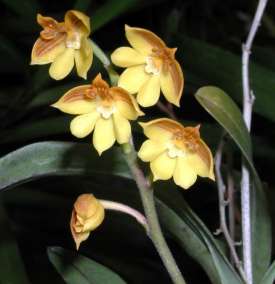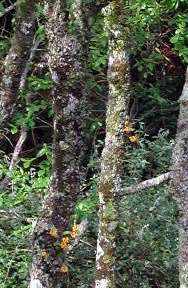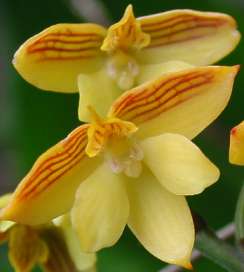Polystachya pubescens
Polystachya pubescens (Lindl.) Rchb.f.
Family: Orchidaceae
Common names: amabelejongosi (Zulu)
Introduction
This delightful bright yellow, fragrant epiphytic orchid is at home on a tree branch in the forest or on a sandstone rock in the full sun.

Description
Description
This plant is an epiphyte, that is it does not grow in the soil but on the branches of trees. It does not use the tree to supply its food but only to support it so that its spongy roots can absorb moisture from mists and rain and nutrients from decaying vegetation.

The flowers arise from the young growth between October and December and are a striking yellow with brown markings and a strong fragrance.
Distribution and habitat
Distribution description
This species is found in the coastal forests from the Eastern Cape in the south to Zululand and Swaziland and will not tolerate low temperatures. In the Pondoland region it can be found growing in large mats on sandstone rocks in the full sun. These plants usually have leaves that are a pronounced purple colour because of the intense light. In the lower light conditions of the forest the plants are green.
Derivation of name and historical aspects
History
The name is derived from the many ( poly- ) branched flower spikes ( stachys ) in some of the species. The genus grows throughout Africa and comprises about 200 species, 11 of which occur in southern Africa. The most common species in South Africa is P. ottoniana.
Uses
Use
Because of its showy flowers and relative ease of culture, there is a demand for plants amongst specialist orchid growers . There are records of the genus being used amongst the amaZulu as a protective charm.

Growing Polystachya pubescens
Grow

This plant grows easily in the milder regions of the country if it is attached to a branch of a tree ( Celtis, Syzigium, Harpephyllum , i.e. a tree with smooth bark) with a piece of old stocking, and kept misted during the hot summer months. No water should be given during winter. A watering of liquid fertilizer once a month when it has sent out roots will ensure strong, healthy plants.
It can also be grown on pine bark slabs or in pots of coarse pieces of pine bark. These plants should be kept in an airy, lightly shaded spot and must be watered and fed regularly. For the more adventurous with access to large sandstone rocks and a mild climate, it might be worth establishing a plant or two on them as the effect would be stunning.
References
- Hutchings, A. 1996. Zulu medicinal plants, an inventory. University of Natal Press, Pietermaritzburg.
- Jackson, W.P.U. 1987. Origins and meanings of names of South African plant genera. University of Cape Town Ecolab.
Credits
Brian Tarr
Natal Nataional Botanical Garden
November 2004
Plant Attributes:
Plant Type: Epiphyte, Orchid
SA Distribution: Eastern Cape, KwaZulu-Natal, Limpopo, Mpumalanga
Soil type:
Flowering season: Early Summer
PH:
Flower colour: Yellow
Aspect: Morning Sun (Semi Shade)
Gardening skill: Average
Special Features:
Horticultural zones








Rate this article
Article well written and informative
Rate this plant
Is this an interesting plant?
Login to add your Comment
Back to topNot registered yet? Click here to register.